The extracapsular repair method of stabilizing a dog’s torn ACL is most commonly performed by general practitioners because of its simplicity and cost.
Sometimes, the extracapsular technique is referred to as the “fishing line technique.”
Extracapsular repair techniques have been available for over 50 years and have proven the test of time as a very beneficial surgery for a torn cranial cruciate ligament.
Two surgical procedures, the lateral suture, and the TightRope are the most common extracapsular repair procedures for a torn cranial cruciate ligament.
Extracapsular means the correction and stabilization occur outside of the joint. Extracapsular procedures do not require a cut in the bone.
As mentioned earlier, the most significant advantages of extracapsular procedures compared to TPLO and TTA are cost and less significant complications.
Lateral Suture Surgery
The lateral suture is the simplest technique requiring an incision on the outside aspect of the knee.
Advantages
The advantages of lateral suture surgery are simplicity, ease of the surgical technique, short operative time, good results, low complication rate, and low cost.
Even if a complication from surgery occurs, the suture can easily be removed and reapplied.
Disadvantages
The main disadvantage of lateral suture surgery is difficulty in the proper placement of the suture.
In other words, the suture must be placed isometrically for best results.
In addition, stretching of the suture may occur requiring revision surgery. Stretching is most common in larger dogs.
TightRope Surgery
The TightRope technique is the most recent advancement in extracapsular stabilization and tries to incorporate as many advantages as possible.
Advantages
The TightRope technique is the strongest extracapsular stabilization implant available today and may perform superior to other extracapsular sutures in respect to suture stretching.
The TightRope technique is also more isometrically placed than other extracapsular techniques.
Disadvantages
The cost is more than the lateral suture and slightly less than the TPLO or TTA.
Why Choose Lateral Suture Surgery Over TPLO or TTA?
Less Complications
With extracapsular surgeries, catastrophic failure necessitating amputation or euthanasia shouldn’t be expected.
If complications do occur, complications of extracapsular surgeries are generally not as disastrous.
Lower Cost
Extracapsular techniques are more cost-effective and easier to perform than osteotomies of the proximal tibia.
The bottom line is if you consult with a Board Certified Surgeon, you can likely expect a recommendation of an osteotomy procedure unless the dog weighs 25 pounds or less.
However, the best veterinarians will take into account the owner’s expectations, the dog’s health status, cost-effectiveness, and more to arrive at the best surgical option for clients and their pets.
Powerful Tools to Help Your Dog’s Ligament Challenges
There are many quick and easy changes you can make at home to help your give your dog an edge on easing tendon and ligament challenges.
- Learn more about torn ligaments and cruciate disease.
- Provide joint support. PET | TAO Harmonize Joint is a blend of Eastern herbs and Western supplements working together to lubricate and restore your dog’s joints.
- Ease your dog’s discomfort naturally. PET | TAO Comfort is a blend of Eastern herbs and Western supplements to soothe your dog’s arthritic challenges to make him/her more comfortable.
- Try PET | TAO Freeze Dried Beef Liver Treats. According to TCVM, liver controls tendons and ligaments. As few as 5-6 treats per day can make a huge difference in your dog’s tendon and ligament health!
- Try a Blood-building TCVM Diet. PET | TAO Zing dog food builds Blood. According to TCVM, Blood deficiency leads to ligament tears.
- Learn more about TCVM Herbal Remedies. Chinese medicine offers many amazing natural solutions for ligament and cruciate challenges. Some good examples are:
Get A Phone Consultation with One of Our TCVM Veterinarians








